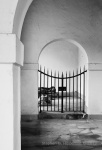Allerton Mauleverer – St. Martin
As St. Martin’s is not too far from where I live, I’ve made a number of visits to this church – hence the variation in the quality of the light between the pictures. Making repeat visits allows me to try different approaches to composition of particular images and to pick up on what I may have missed in previous visits. Indeed, this next image had to be produced with me standing on top of a set of 7 tread aluminium steps (quite a dodgy experience in the road). I needed them to give me enough height to just get the bottom of the door above the wall. Because the relative height of the church with respect to the road a straight on shot loses the tower from the composition.
St. Martin’s is no longer used as a formal place of worship and is under the care of the Churches Conversation Trust.
Inside St. Martin’s.
A some what un
what un usual feature of the church is the position
usual feature of the church is the position  of the tower in relation to the chancel and nave, occupying the space between both, effectively creating a corridor and as a consequence it’s almost impossible to get a good view of the alter from the pews. This image is taken from a position in the chancel looking down towards the nave. There are small rooms to the left and right of the ‘corridor’.
of the tower in relation to the chancel and nave, occupying the space between both, effectively creating a corridor and as a consequence it’s almost impossible to get a good view of the alter from the pews. This image is taken from a position in the chancel looking down towards the nave. There are small rooms to the left and right of the ‘corridor’.
The Font
The Hammerbeam Roof.
Commemorative Plaque
The headquarters for No 6 Group was at Allerton Park, in which St. Martin’s located. The church was their nearest place of worship, being just a few hundred yards from Allerton Castle.



Wooden effigies of cross-legged knights of late 13th or early 14th Century. Brass of Sir John and Eleanor Mauleverer, 14th Century. Alabaster effigies of Sir John and Alyson Mauleverer (1475). (2)
The Ten Commandments
Stained Glass



The East Window with glass by William Peckitt and two examples of heraldic design.
Incidentals
——–Stephen———-
































A gorgeous church and photo set.
Question: Are many of the churches in the outlying, rural districts are under conservation care?
The Church of England alone recognises 16,500 churches, then there would be RC churches and other denominations. The Conservation Trust I refer to maintain a small number of 341 historic churches – some of these will be ‘working’ churches while others are de-commissioned for general use – though it’s not unusual for them to hold the occasional service in them.
The location of rural churches can be seem a bit of a mystery if you look at a map, but the population of the countryside has changed significantly over time – huge churches now serve small communities, sometimes churches may be 1/2 mile outside the existing village. Some churches stand alone.
Fascinating stuff.
Very fascinating stuff. Thanks.
Beautiful photos, beautiful blog, thank you for sharing.
thank you, you’re very kind.
Stephen, I’d like to use an image or two of the Church in a self published book of less than a dozen copies. It is on Colonel Thomas Thornton whose mother is buried there. Its one of the few remaining edifices from his time there (1789-1805). Let me know. Great photographs by the way
Hi John,
Drop me an email to stephenhip@hotmail.co.uk.
Cheers
Stephen